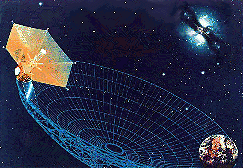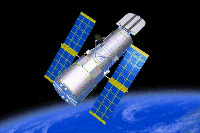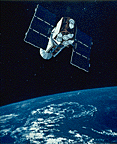|
|
Observatories in space
Radio observatories

At present, there are no
radio observatories
in space. There are plans, however, for two in the coming years. They are
the Very Long Baseline Interferometry (VLBI) Space Observatory Program (VSOP),
a Japanese mission with a scheduled launch date of January 1997, and
RADIOASTRON, a Russian mission schedule for 1998. NASA
will be supporting both missions with its Deep Space Network radio telescope
facilities around the world.
Radio waves CAN make it through the Earth's atmosphere without significant
obstacles (In fact radio telescopes can observe even on cloudy days!).
However, the availability of a space radio observatory complements
radio telescopes on the Earth in some important ways.
One is a special technique used in radio
astronomy called
"interferometry". Radio astronomers can combine data from two
telescopes that are very far apart and create
images which have
the same
resolution as if they had a single telescope as big as the distance
between the two telescopes! That means radio telescope arrays can see
incredibly small details. One such array is called the Very Large Baseline
Array (VLBA): it consists of ten radio telescopes which reach all the way from
Hawaii to Puerto Rica: nearly a third of the way around the world! But by
putting a radio telescope in
orbit around the
Earth, radio astronomers could make images as if they had a radio telescope
the size of the entire planet!

Microwave observatories
There are no
microwave
observatories in space right now nor are there any major microwave
observatories planned that I know of... Mail me if you know of any!
The most recent microwave observatory was the
Cosmic Background Explorer (COBE) (http://space.gsfc.nasa.gov/astro/cobe/) which observed the entire sky making
very precise measurements of the temperature of the "microwave
background".
The sky is a source of microwaves in every direction, most often called the
microwave background. This background is believed to be the remnant from the
"Big Bang" scientists believe our universe began with. It is
believed that a very long time ago all of space was scrunched together in a
very small, hot ball. The ball exploded outward and became our universe as it
expanded and cooled. Over the course of the past several billion years (the
universe's actual age is still a matter of debate, but is believed to be
somewhere between ten and twenty billion years), it has cooled all the way to
just three degrees above zero. It is this "three degrees" that we
measure as the microwave background.
COBE mapped out the entire microwave background, carefully measuring very
small differences in temperatures from one direction to another. Astronomers
have many theories about the beginning of the universe and their theories
predict how the microwave background would look. The very precise measurements
made by COBE eliminated a great many of the theories about the Big Bang.

Infrared observatories
The biggest
infrared
observatory currently in orbit is the brand new
InfraredSpace Observatory (ISO) (http://isowww.estec.esa.nl/), launched in November 1995 by the European Space
Agency. ISO will operate for at least two years barring unforeseen
circumstances. It has been placed in an elliptical orbit with a 24 hour period
which keeps it in view of the ground stations at all times, a necessary
arrangement since ISO transmits observations as it makes them rather than
storing information for later playback. ISO will able to observe from 2.5 to
240 microns.
Late next year, NASA plans to launch the
Space Infrared Telescope Facility (SIRTF) (http://sirtf.jpl.nasa.gov). SIRTF will use an passive cooling
system (i.e. it radiates away its own heat rather than requiring an
active refrigerator system like most other space infrared observatories) and
it will be launched well away from the Earth where it will not have to contend with Earth
occultation of
sources nor with the comparatively warm environment in near-Earth space.
Another major infrared facility coming soon will be the Stratospheric
Observatory for Infrared Astronomy (SOFIA). Although SOFIA will not be an
orbiting facility, it will carry a large telescope within a 747 aircraft flying
at an altitude sufficient to get it well above most of the Earth's infrared
absorbing atmosphere. SOFIA will be replacing the Kuiper Airborne
Observatory.

The only visual observatory in orbit at the moment is the Hubble Space
Telescope (HST). Like radio observatories in space, there are
visible
observatories already on the ground. However, Hubble has several special
advantages over them.
HST's biggest advantage is, because it is above the Earth's atmosphere, it
does not suffer distorted vision from the air. If the air was all the same
temperature above a telescope and there was no wind (or the wind was perfectly
constant), telescopes would have a perfect view through the air. Alas, this is
not how our atmosphere works. There are small temperature differences, wind
speed changes, pressure differences, and so on. This causes
light passing
through air to suffer tiny wobbles. It gets bent a little, much like light
gets bent by a pair of glasses. But unlike glasses, two light beams coming
from the same direction do not get bent in quite the same way. You've probably
seen this before -- looking along the top of the road on a hot day, everything
seems to shimmer over the black road surface. This blurs the image
telescopes see, limiting their ability to resolve objects. On a good night in
an observatory on a high mountain, the amount of distortion caused by the
atmosphere can be very small. But the Space Telescope has NO distortion from
the atmosphere and its perfect view gives it many many times better resolution
than even the best ground-based telescopes on the best nights.
Another advantage of the Space Telescope is that without the atmosphere in
the way, it can see more than just the visible
spectrum. The
Space Telescope can also see
ultraviolet
light which normally is absorbed by the Earth's atmosphere and cannot be seen
by regular telescopes. So the Space Telescope can see a much wider portion of
the spectrum.

Ultraviolet observatories
Right now there are no dedicated ultraviolet observatories in orbit. The
Hubble Space Telescope can perform a great deal of observing at ultraviolet
wavelengths,
but it has a very fairly small field of view. Until September
1996, the International Ultraviolet Explorer (IUE) was operating and observing
ultraviolet radiation. Its demise, although unfortunate, was hardly premature:
IUE was launched in January, 1978 with planned operations of three years. IUE
functioned more or less like a regular ground based observatory save that
the telescope operator and scientist do not actually visit the telescope, but
send it commands from the ground. Other than some care in the selection of
materials for filters, a UV telescope like IUE is very much like a regular
visible light telescope.
In addition to IUE, there have been fairly important recent UV space
missions. A reusable shuttle package called Astro has been flown twice in the
cargo bay of the space shuttle: it consisted of a set of three UV telescopes.
Unlike HST, the Astro UV telescopes had very large fields of view and so could
take images of larger objects in the sky -- like galaxies. For instance, if
the Hubble Space Telescope and the Astro telescopes were used to look at the
Comet Hale-Bopp, Hubble would be able to take spectacular pictures of the core
of the comet. The Astro telescopes would be able to take pictures of the
entire comet, core and tail.

Extreme Ultraviolet observatories
There are two extreme ultraviolet observatories in space at the moment.
One of them is the very first extreme ultraviolet observatory ever, the
ExtremeUltraviolet Explorer (EUVE) (http://www.cea.berkeley.edu/).
Astronomers have been somewhat reluctant to explore from space at the extreme
ultraviolet wavelengths since all theory strongly suggests that the
interstellar
medium (the tiny traces of gases and dust between the
stars) would absorb
radiation in this portion of the spectrum. However, when the Extreme
Ultraviolet Explorer (EUVE) was launched, observations showed that the solar
system is located within a bubble in the local interstellar medium. The region
around the Sun is relatively sparse of gas and dust which allows the EUVE
instruments to see much further than theory predicted.
Another extreme ultraviolet observatory currently operating is the
Array of Low Energy X-ray Imaging Sensors (ALEXIS) (http://nis-www.lanl.gov/nis-projects/alexis/). Although its name
indicates that it is a
X-ray observatory,
the range of energy ALEXIS is exploring is at the very lowest end of the
X-ray spectrum and often considered to be extreme ultraviolet. ALEXIS was
launched in 1995 on a Pegasus XL launch vehicle, but a
failure during the launch tore off one of the solar panels and the
satellite is
tumbling through space. Nonetheless, the ALEXIS operations team has
been able to use the
tumbling of the satellite to map out the entire sky.

X-ray observatories
There are several X-ray observatories currently operating in space with many
more to be launched in the next few years.
The
Rossi X-ray Timing Explorer
(RXTE) was launched on December 30, 1995. RXTE is able to make very
precise timing measurements of X-ray objects, particularly those which show
patterns in their X-ray emissions over very short time periods, such as certain
neutron star
systems and
pulsars.
Other X-ray observatories currently operating in space include the
Advanced Satellite for Cosmology
and Astrophysics (ASCA), a joint U.S.-Japan venture; the
Kvant astrophysics module
attached to the Russian space station Mir, and
SAX, an Italian X-ray satellite. The most recent addition to these
X-ray observatories is NASA's Chandra
X-ray Observatory (CXO), launched from the space shuttle in July,
1999.

Gamma-ray observatories
The
Compton Gamma-Ray Observatory (CGRO) was launched by the space shuttle in
April 1991. The observatory's instruments are dedicated to observing the
gamma-ray sky, including locating
gamma-ray burst
sources, monitoring
solar flares,
and other highly energetic astrophysical phenomenon. An unexpected discovery
which Compton has made was the observation of gamma-ray burst events coming
from the Earth itself at the top of thunderstorm systems. The cause of this
phenomenon is not known, but it is currently suspected to be related to
"Sprites": lightening flashes which are occasionally seen jumping
upwards from cloud tops to the upper stratosphere.
The Russian gamma-ray observatory
Granat has exhausted its
control fuel. Its last maneuver was to initiate a roll which has allowed it
to perform a continuous all-sky survey.
The next major gamma-ray mission in the near future include the joint
U.S.-Russia missions
Spectrum X-Gamma (http://hea-www.harvard.edu/SXG/sxg.shtml) which will make pointed observations in both X-ray and gamma-ray
wavelength regimes.
|
